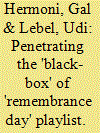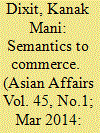| Srl | Item |
| 1 |
ID:
120361


|
|
|
|
|
| Publication |
2013.
|
| Summary/Abstract |
This article examines the musical repertoire broadcast on Israeli state radio stations on Remembrance Day. Commencing with the first Remembrance Day, Israeli radio stations have refrained from broadcasting songs that do not contribute to the glorification of the military mythology or failure to reinforce the consensual perception of national loss. In view of globalization - it might be assumed that Remembrance Day songs would undergo changes in tune with the times. From a musical point of view, new songs that belong to what Regev and Seroussi classify as 'globalizing Israel' penetrated into the nationalist arena. But, following Inglehart and Baker, these songs, despite their seemingly secular façade, remain limited hegemonic enclosures organized around the core of founding values. Apparently, this is an example of the process of glocalization of culture. The article seeks answers to the strategies employed to accommodate these new songs to the traditional ideology of the classical Remembrance Day songs and examines whether the mechanisms of legitimacy that enable the inclusion of new voices on Remembrance Day, can be identified. We argue that their choice is not arbitrary and that they illustrate the manner by which voluntary cultural entrepreneurs (musical editors) are co-opted in the postnational condition.
|
|
|
|
|
|
|
|
|
|
|
|
|
|
|
|
| 2 |
ID:
128029


|
|
|
|
|
| Publication |
2014.
|
| Summary/Abstract |
With Partition and the rise of various different nationalisms there came the need to find a new name for what used to be called "British India". A framework for co-operation between the new countries was also needed. Initially regionalism was fashionable. But the regional organisation, SAARC, embodied cooperation between all the nation-states of the region, a veritable lowest common denominator rather than an additional layer of an inclusive regional identity for all the citizenry. The increasing use of "Southasia" is based on a recognition that even though India looms large, the region contains other countries with sizeable populations in a global context. But flesh must be put on the bones of the concept. The key is sub-regional commercial cooperation between viable units. There are many opportunities for cross-border economic activity, but what is needed is a porous border like the India/Nepal border, not a militarised border like the India /Pakistan border. Connectivity and bilateral free trade agreements will bring results and the Indian state of Punjab and the Pakistani province of Punjab are perhaps best placed to give an example of cooperation.
|
|
|
|
|
|
|
|
|
|
|
|
|
|
|
|
| 3 |
ID:
157223


|
|
|
|
|
| Summary/Abstract |
Lao nationalism is usually thought to have emerged only at the end of the French colonial period during the Lao Renovation Movement (1941–1945), placing its origins much later than elsewhere in Southeast Asia. Yet when surveying Lao palm leaf manuscripts, it is evident that Lao scribes were writing in uniquely modern ways about themselves and others as early as 1890, three years prior to French colonization. They wrote in response to recent upheavals seen in the north amidst the Ho Wars (1869–1889) and the related migrations from south China during the mid- to late 19th century, and their accounts included highly-charged descriptions of newly arrived ethnic groups that subtly redefined what it meant to be Lao. These developments suggest an earlier origin to Lao ethnic nationalism at the turn of the century, which anticipated the later, more intense changes to appear in the French colonial era (1893–1945). Emphasis is placed on significant connections between the precolonial and colonial periods.
|
|
|
|
|
|
|
|
|
|
|
|
|
|
|
|